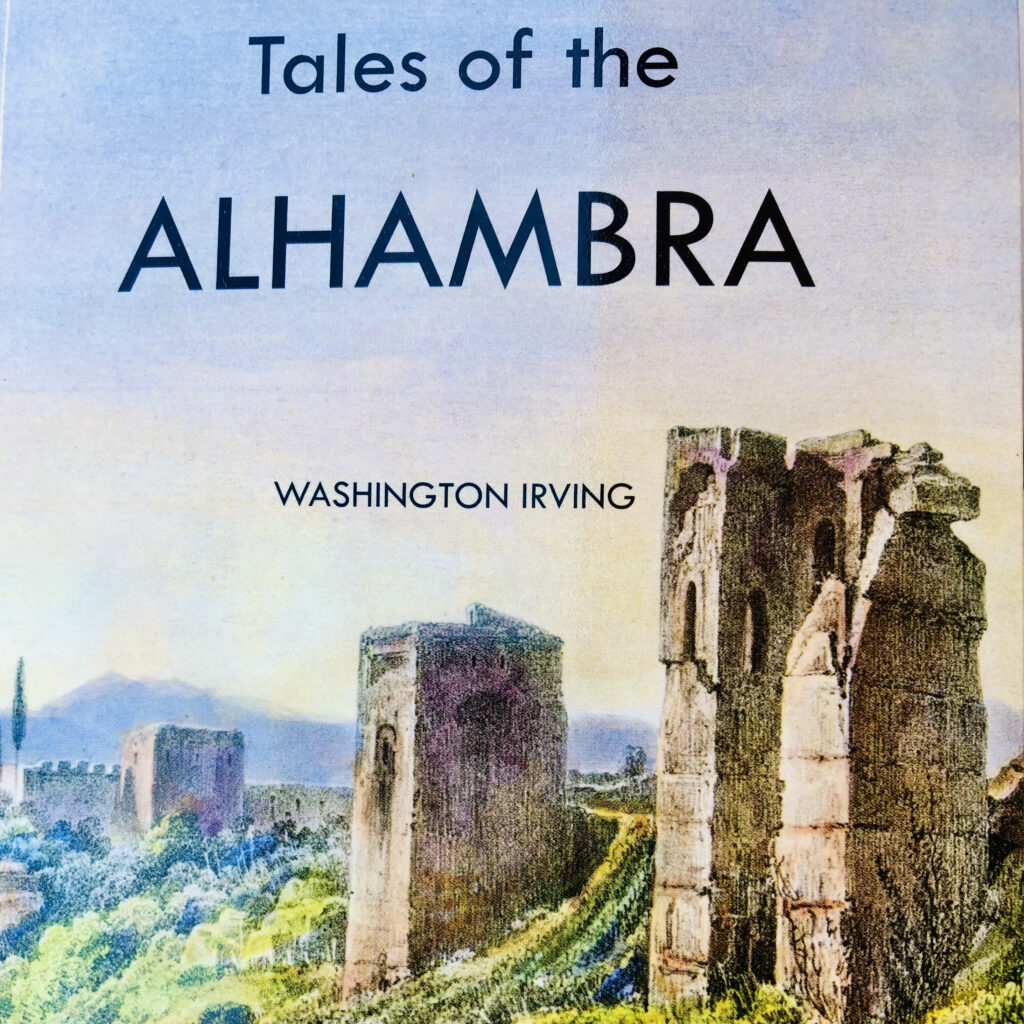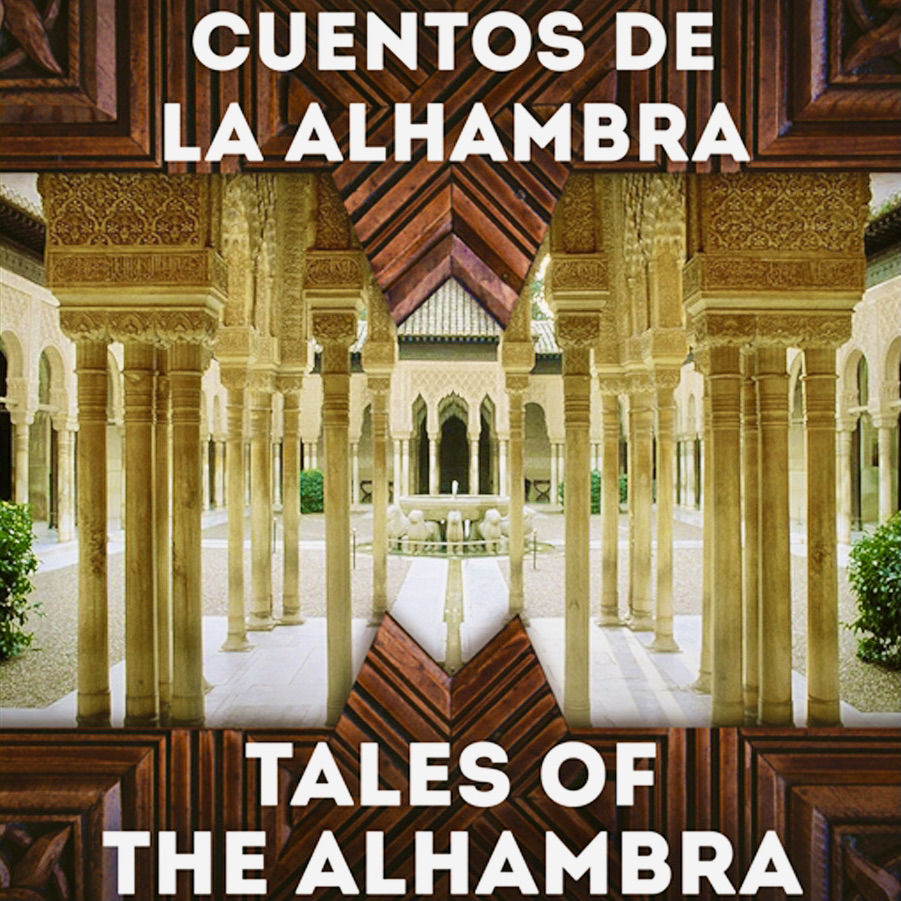Table of Contents
Children’s tales for visiting the Alhambra
Are you thinking of visiting Alhambra with the kids?
It would be great if children learned something about the Alhambra before the visit and let their imagination wander when they see it.
So you can read in this article children’s tales Alhambra to let their imagination fly.
This wonderful monument is filled with secrets and history, with towers, gardens, and palaces, a place full of legends and mysteries, surrounded by the ancient walls that will not leave children indifferent to children.
In this article, I want to show you three tales written on a book by Washington Irving about the Alhambra and its legends dedicated especially to children:

Children’s tale for visiting the Alhambra: El soldado encantado- The Legend of the enchanted Soldier
A student of the University of Salamanca spent summers traveling to different cities, and he was playing the guitar to make some money and be able to pay for his studies.
In one of these trips, he came to visit the city of Granada, and according to the legend, during a walk, he met a soldier with armor and a spear, a soldier from an old era.
The student asked him for his identity, and he told him he had wandered about 300 years due to a curse that forced him to protect and guard the treasure of King Boabdil for eternity. The soldier told him that he could only leave the treasure once every hundred years.
The soldier asked the student for help to break the spell, for he needed a Christian girl and a fasting priest. The Christian girl wasn’t difficult to find, but the only priest he found was an obese one, who loved to eat, so only with the wealth promise he accepted to help him.
The young student brought together the two of them, the young woman and the fasting cleric and the three that night went to the hideout where the soldier was to break the spell.
However, during the ritual, the priest couldn’t fulfill his promise, and his greed made him pounce on the food they had prepared for late. The spell couldn’t be broken, and the soldier wasn’t freed from the curse. Still keeps Boabdil treasures.
There are more tales of the Alhambra you can read to your kids to let their imagination fly when visiting this fantastic palace.
Here we go with…

Princess’ tale of the Alhambra: Las tres hermosas princesas – The three beautiful princesses
Once long ago, Granada was ruled by the Moorish prince, Mohammed, also known as Mohammed the Left-handed. Riding his horse one day through the Elvira mountains, Mohammed came across a line of horse riders returning from a foray into Christian lands. Among their captives was a beautiful young woman, weeping.
Mohammed claimed the young beauty as his royal share of the plunder and resolved to take her back to his harem at the Alhambra and make her his queen.
When Mohammed realized that his attempts to woo the girl were to no avail, he decided to enlist her maid Kadiga, in his favor. Kadiga spoke to the young captive: “Why such weeping and sadness?” the maid asked her mistress. “You are marrying him, not his religion, and if he is old, well, the sooner you’ll be a widow.”
Kadiga’s words had the desired effect and the Moorish king soon became a father to three beautiful princesses. As was the custom of the Muslim kings, he consulted his astrologers, who told him: “Daughters, my lord! They will need a watchful eye when they reach marriageable age”. The queen died a few years later, leaving her beloved daughters in the care of the discreet Kadiga. The king decided the princesses would grow up in the Salobreña royal castle, an impenetrable fortress where they were surrounded by every possible luxury. The princesses were called Zayda, Zorayda and Zorahayda.
One morning Mohammed the Left-handed was to be found sitting on a divan when a slave arrived with apricot, a peach, and a nectarine. The monarch understood that his daughters were ready to be married and set off to find them.
On arriving at Salobreña he gazed upon them proudly. The entourage began its journey, but when it approached Granada a convoy of prisoners could be seen. Among them were the three handsomely dressed knights that the princesses had seen from the pavilion.
The princesses listen to him when they where in Salobeña and them hearts fell in love for him.
Alone with them, Kadiga tried to win their trust.
“My darling girls, what is the reason for your sadness? Shall I ask the famous black singer Casem to come?” she asked.
“I have lost my interest in music”, said the sweet Zorahayda.
“Oh, my dear girl! You wouldn’t say that, if you had heard the music that I heard last night from the three Spanish gentlemen who crossed our path”, said the old woman teasingly.
“And could you not find some way for us to see them, mother?” asked Zayda.
Kadiga went to see Hussein Baba, the man guarding the knights, and sliding a gold coin across to him, asked him to put the Christians to work next to the tower where the princesses slept.
The next day the princesses delighted in the soft songs of their troubadours.
“Oh, my girls!” she shouted, “the knights have been rescued by their families and they are in Granada preparing to return to their countries.” The love-struck princesses were distraught.
Kadiga told him that the young christians wanted to marry in their christian kingdoms, but the only way was to escape with them.
At midnight the discreet Kadiga heard the signal from the bribed guard, Hussein Baba. Kadiga tied the rope from a stair to the mullioned window and slid down.
The two older princesses followed, but when it came to Zorahayda’s turn she dropped the rope. The two older princesses tumbled to the underground passageway. The Spanish knights were waiting, dressed as Moorish soldiers. They sat on the horses with their lovers and discreet Kadiga rode behind the guard and the party set off for Córdoba.
It should be mentioned that at the last moment the little girl felt very sorry for her father and did not leave with her loved one, being locked up forever in one of the towers of the Alhambra. Even today when you pass through Medina, you can see the tower of the well-known Infants.

Before visiting the Alhambra with kids, read this children tale: El legado del moro – Legend of the Moor’s Legacy
In the Square of the Cisterns, fronting the royal palace in the fortress of the Alhambra, was a deep Moorish well of clear, cold water. So famous was the well throughout all Granada that to it repaired water carriers from every quarter of the city.
The well was also a great place for meeting and gossip. Each day, housewives, lazy servants, beggars—idlers of every age and condition—gathered on the stone benches to talk over the doings of their neighbours.
Among the carriers who drew water from the ancient well of the Alhambra was a strong-backed, named Pedro Gil, called Peregil for short.
He had begun his trade with only a single water jar, but since no one in all Granada was more industrious than he, it was not long before he was able to purchase a donkey to do his carrying for him. All day long, for every woman, old or young, he had a merry smile and a pleasing compliment. It was not surprising that everyone thought him the happiest of men.
His wife, spent his hard-earned money for fripperies they could not afford. Subdued to patience by his matrimonial yoke, Peregil made the best of the situation and concealed his frequent dejection with merry quips and songs.
Late one summer night, he made one last trip. He found the square empty except for a stranger in a Moorish dress. When the man said that he was a traveller taken suddenly ill, Peregil, touched with compassion, gave the stranger a ride back to the city on his donkey. On the way, the man confessed that he had no lodgings in the town, and he asked that he be allowed to rest under Peregil’s roof. He promised that the carrier would be well repaid.
Peregil had little desire to deal in this manner with an infidel, but in the kindness of his heart, he could not refuse aid to the stranger. Ignoring his wife’s protests, the carrier spread a mat in the coolest part of his hovel for the sick man. Before long the Moor was seized with convulsions. Knowing that his end was near, he gave Peregil a small sandalwood box and told him that it contained the secret to a great treasure. He died before he could reveal the nature of the secret.
Peregil’s wife, afraid that the body would be found in their house and that they would be charged with murder, railed at her husband for his folly. Equally disturbed, the carrier tried to mend matters by taking the dead Moor, under cover of darkness, to the bank of the river and there burying him.
Now it happened that Peregil lived opposite to a barber named Pedrillo Pedrugo, whose greatest pleasure was to spy on his neighbours and tattle on their affairs. Having seen Peregil arriving with the Moor, he was still on watch when the carrier took away the body of the dead man. Following stealthily, he spied on the secret burial. Early the next morning, he hurried off to the Alcalde, who was one of his daily customers, and told what he had seen.
The Alcalde, sent a constable to bring Peregil before him. Frightened, the water carrier called upon the saints to witness his innocence and frankly related the whole story. When he produced the sandalwood box, the Alcalde expected to find it filled with gold or jewels. Instead, it contained only a parchment scroll and the end of a wax taper. Disappointed, he returned the box to Peregil, but kept the carrier’s donkey to pay for the trouble the poor wretch had caused.
At home, Peregil became so disgusted with his wife’s taunts over the loss of his donkey that he threw the sandalwood box to the floor. When the parchment rolled out, he picked it up and found some writing in Arabic. Curious, he took it to a Moorish shopkeeper of his acquaintance. The Moor said that the scroll contained an incantation for the recovery of a treasure hidden under the Alhambra.
At first, Peregil was sceptical. Several days later, he heard loiterers by the well talking about a treasure supposed to be buried under the Tower of the Seven Floors in the old fortress.
Once more, he went to the Moor and proposed that they search for the treasure together. The Moor replied that the incantation was powerless without a magic candle to burn while the charm was being read. Peregil said that the taper was also in his possession.
Later that night, he and the Moor went secretly to the Tower of the Seven Floors and descended into the damp. There they lit the taper, and the Moor began to read the words on the parchment. As he finished, the floor opened with a noise like thunder.
Descending the steps thus revealed, they found themselves in another vault, where stood a chest and several great jars filled with gold coins and precious stones, over which two enchanted Moorish warriors stood guard. Amazed and fearful, they filled their pockets with valuables. Then they climbed the stairs and blew out the taper. The floor closed again with a ponderous crash.
Peregil and the Moor hoped to keep their secret safe, but the carrier could conceal nothing from his wife. She bought herself expensive clothing and her neighbours became curious. One day, the barber saw her after she had decked herself with some of the jewels Peregil had found. Once more Pedrillo hurried to the Alcalde to tell his story. The Alcalde, convinced that Peregil had tricked him, ordered the trembling water carrier dragged into his presence.
After Peregil’s story had been confirmed by the Moor, the Alcalde’s greed for gold became almost more than he could bear. That night, taking Peregil and the Moor with them as prisoners, the Alcalde, the constable, and the prying barber went to the tower.
They took the donkey Peregil had once owned with them. There in the vault, the taper was lighted, and the Moor read the incantation. Again the floor rolled aside, revealing the treasure vault beneath. The Alcalde and his friends ordered Peregil to bring up two immense jars filled with gold and gems and to strap them on the donkey which they had brought to carry away the spoils.
When they learned that the vault also contained a chest filled with treasure, the Alcalde, the constable, and the barber overcame their fears sufficiently to go down the stairs to secure the riches for themselves. After they had entered the lower vault, the Moor blew out the taper, and the floor closed over the men below, leaving them entombed in darkness. The Moor, assuring Peregil that such was the will of Allah, threw away the magic taper.
Peregil and the Moor divided the treasure equally between them. A short time later, the Moor returned to his native city of Tangier. Peregil, with his wife, his brood of children, and his sturdy donkey, went to Portugal, where his wife used his riches to make him a man of consequence, known to all as Don Pedro Gil. As for the greedy Alcalde, the constable, and the prying barber, they remain under the Tower of the Seven Floors to this day.

Why read books and storytelling with children before visiting a new place?
Reading and storytelling with babies and children promotes brain development and imagination, develops language and emotions, and strengthens relationships.
Anytime is a good time for a book or story!
And of course, before visiting Granada those are the books that they can enjoy to come to the Alhambra and enjoy it even more with their imagination. You can also buy the books and read them at home to remind the magical places you have visited.
Do you need ideas for visiting Granada with kids?
If you want to know more about this fantastic city, click the link below to download my free Ebook with all you need to know before visiting Granada.
Quick reminder: you can also book a guided tour dedicated to families with kids!




Comment (0)